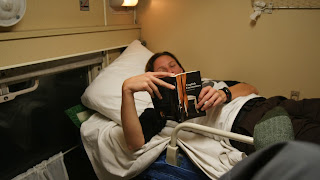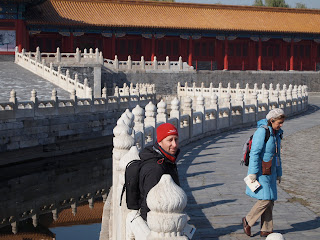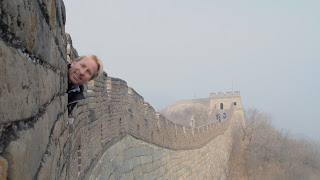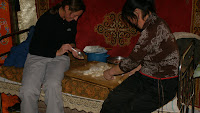 Our Nepalese driver insured us that we would go slow and drive safely, unlike the Chinese drivers who he described as manic in comparison to Nepalese drivers. Well, the bus driver with a bus load of passages (thankfully none on the roof) driving at a hundred miles an hour on the wrong side of the road around a blind corner was either Chinese or didn't get the memo! A few holy F's passed my lips. It's not worth repeating what Nick said. All this happened within the first hour of a 5 hour drive. Here is more proof that Nepalese drivers are no better.... A common sight on the roads.
Our Nepalese driver insured us that we would go slow and drive safely, unlike the Chinese drivers who he described as manic in comparison to Nepalese drivers. Well, the bus driver with a bus load of passages (thankfully none on the roof) driving at a hundred miles an hour on the wrong side of the road around a blind corner was either Chinese or didn't get the memo! A few holy F's passed my lips. It's not worth repeating what Nick said. All this happened within the first hour of a 5 hour drive. Here is more proof that Nepalese drivers are no better.... A common sight on the roads.Ka Ka Ka Ka Ka Ka Ka Ka Katmandu is Cr Cr Cr Cr Cr Crazy! After the peace and tranquility of Tibet the constant racket of cars, scooters, horns, tuk-tuks and tiger balm sellers we couldn't wait to get into our room and shut Katmandu out. Alas, food and curiosity dragged us out.
Nick was screaming for some western food, well anything but Yak, which lead us to the Lonely Planet recommendation called 'The Roadhouse'. Once we were seated we noticed we were surrounded by other westerners all dressed in the same knock-off Northface puffer jacket celebrating their trek or preparing for their trek. The clothes and conversation may have been slightly different, but it felt all to familiar. We could have been in any restaurant in the UK or NZ not Nepal. It was kinda disappointing after being isolated from Western culture for so long. The food was great, though!
Nick's man flu was peaking and I was refusing to except that I was feeling a bit run-down myself, which most likely didn't help with our first impression of Nepal. We soldiered on regardless making it to Bhaktapur, a Newari town semi void of traffic and tiger balm sellers. Unfortunately, some political party was using Bhaktapur square as a platform to spread their political message. Forcing us to venture deeper in the ancient city. This turned out to more ideal, we no longer had to deal with the crowds or the same annoying boy who seemed to refuse to understand that we didn't want a guide.

The Lonely Planet was no help at all in filling our brains with useful information on Bhaktapur architecture and the many Hindu and Buddhist religious sites and shrines. The Lonely Plant was thrown in favor for just wondering the quieter backstreets of the town observing the normal daily activities of it's residences.
We did strike it luck on day 2 at the town of Dakshinkdi. A Hindu blood sacrifice temple dedicated to Kai, Shiva's bloodthirsty incarnation. Every Tuesday and Saturday devoted Hindu's trek to the spooky open air temple to make an offering of a male un-castrated animal. In return Kai offers protection. Unknown to us it was Saturday, by the time we arrived the temple was already bathed in marigold flowers, butter lamps, coconuts and blood. We managed to get a prime position above the temple that allowed us to watch the sacrifices. First up was a chicken, not so bad, had seen it before. Next was a goat, ok, was a little horrified as it continued to twitch. Then we saw the nearly mature calf! It's legs were tied together and it was being dragged by it's hoofs to it's death. I really didn't need to see it's throat being cut but curiosity got the better of me. I soon wished I hadn't.
 Still reeling at we had seen, we moved on to to Bodhnath. A small Buddhist town close to central Katmandu, where hundreds of exiled Tibetans and a few foreign monks call home. At it's heart is the worlds largest Stuppa. Unlike the Stuppas in Tibet, Bodhnath does not contain any mummified Dali Lamas, scriptures or relics, however it was built in AD 600 and no animal were harmed.
Still reeling at we had seen, we moved on to to Bodhnath. A small Buddhist town close to central Katmandu, where hundreds of exiled Tibetans and a few foreign monks call home. At it's heart is the worlds largest Stuppa. Unlike the Stuppas in Tibet, Bodhnath does not contain any mummified Dali Lamas, scriptures or relics, however it was built in AD 600 and no animal were harmed.To finish the day we visited Nepal's most important Hindu temple, Pashupatinath. We arrived at the conclusion of the Bala Chaturdashi fair. By the amount of plastic bags, barley seeds and straw covering the entire complex it must be a popular fair. As we are un-Hindu's we were not allowed to enter Pashupatinath Temple or other Hindu temples within the complex. We had to be satisfied with glimpsing at Shiva bull, Nandi golden backside from the entrance.
We wondered pass the temple towards the river and smoke. The river is called the Bagmati River, a holy river like the Ganges in Varansi, India. The smoke was coming from large stone pillars along the river. And it was human bodies that was burning! We didn't know this when standing down wind to have a nosey, until a nice young man came over to explain that on paying 10000 rupees you can have your body cremated on this holy river. Moving on quickly while brushing the ashes of the dead off us we came across these guys.....
HOLY MEN, there is nothing holy about them. They lounge around the temple all day smoking weed and charging tourist for taking their photo. Apparently, one day a year everyone is allowed to smoke weed legally on the temple grounds. The young man said there is just as much western hippies as there are locals.
For a change in pace and in hope of seeing the majestic Bengal Tiger, we traveled south to Chitwan National Park. We spent 3 days and 2 night on an island in the jungle, traveling by foot, elephant and jeep searching for a tiger. We were unsuccessful. However, the rare one horn rhino and the shy Sloth Bear with a cub was spotted.
There is a rhino among the the bush. We were on a elephant who was vibrating! Guessing he was scared or communicating to the rhino.
On the first walking tour, the guide took us deep into the jungle to explain the 'rules of encounter'. In his broken english, we think you stand completely still or hide behind a tree if being charged by a rhino. Standing in a circle making a lot of noise will hopefully scare a sloth bear off, while looking down and backing away will, maybe, stop a tiger from having you for lunch. If all this fails we had a 60 year old man with a bad hip (a result from being attacked by a rhino) and a big stick to defend himself and us. Perfect!
I was also given the chance to bath a elephant. That was what I was lead to believe....
It was so nice to chill out in the sun with a few beers listening to the peacefulness of the jungle.
The highlight of Nepal was leaving! Somehow we had managed to get first class plane tickets. As we settled into seats with the free Kingfisher beers the plane flew at the same attitude as the Himalayas. What a magical sight, seeing the days last rays of sun illuminate the famous snowcapped peaks.














































